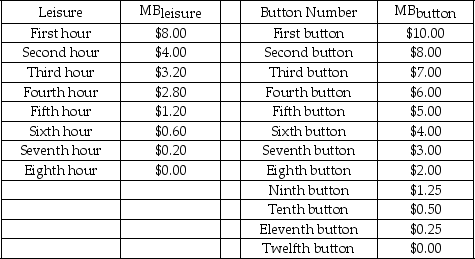Scenario: This problem applies the principle of optimization covered in Chapter 5 to the problem of choosing how many hours to work. Paul has to decide how many hours to work per day. His boss is willing to give Paul whatever hours Paul wants up to 8 hours. All else being equal, he would rather not work, that is, Paul has positive marginal benefit from each hour of leisure. But he is an avid collector of presidential campaign buttons. The more leisure he takes, the fewer buttons he can afford. So Paul faces a trade-off between leisure and buttons. Each button costs $1.00. The table below shows Paul's marginal benefits from leisure (MBlₑᵢsᵤᵣₑ) and buttons (MBbᵤttₒn) .

-Refer to the scenario above.If the hourly wage increases from $1.00 to $1.60,Paul would choose to work ________.
A) more hours
B) the same number of hours
C) fewer hours
D) as much as he can (8 hours)
Correct Answer:
Verified
Q90: The following table shows the hours of
Q91: Which of the following statements is true?
A)
Q92: Which of the following statements is true?
A)
Q93: The following table shows the demand and
Q94: The following figure depicts the production of
Q96: Refer to the scenario above.The increase in
Q97: Marnie works at the guest check-in desk
Q98: As the income of an individual increases,she
Q99: In the case of leisure,the substitution effect
Q100: If there is an increase in the
Unlock this Answer For Free Now!
View this answer and more for free by performing one of the following actions

Scan the QR code to install the App and get 2 free unlocks

Unlock quizzes for free by uploading documents